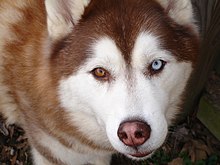Siberian Husky
It is recognizable by its thickly furred double coat, erect triangular ears, and distinctive markings, and is smaller than the similar-looking Alaskan Malamute.[2][4] It is an active, energetic, resilient breed, whose ancestors lived in the extremely cold and harsh environment of the Siberian Arctic.[2] Today, the Siberian Husky is typically kept as a house pet, though they are still frequently used as sled dogs by competitive and recreational mushers.[4] Several Arctic dog breeds, including the Siberian, show a significant genetic closeness with the now-extinct Taimyr wolf of North Asia due to admixture.This introgression could have provided early dogs living in high latitudes with phenotypic variation beneficial for adaption to a new and challenging environment.[13] Siberian Huskies come in a variety of colors and patterns, often with white paws and legs, facial markings, and tail tip.[18] The American Kennel Club describes the Siberian Husky's eyes as "an almond shape, moderately spaced and set slightly obliquely".The AKC recommends the tail should be expressive, held low when the dog is relaxed, and curved upward in a "sickle" shape when excited or interested in something.[32] Health issues in the breed are mainly genetic, such as seizures and defects of the eye (juvenile cataracts, corneal dystrophy, canine glaucoma and progressive retinal atrophy) and congenital laryngeal paralysis.At this time, "Esquimaux" or "Eskimo" was a common pejorative term for native Arctic inhabitants with many dialectal permutations including Uskee, Uskimay and Huskemaw.Leonhard Seppala, the foremost breeder of Siberian sled dogs of the time, participated in competitions from 1909 to the mid-1920s with a number of championships to his name.The plaque upon it is inscribed, Dedicated to the indomitable spirit of the sled dogs that relayed antitoxin six hundred miles over rough ice, across treacherous waters, through Arctic blizzards from Nenana to the relief of stricken Nome in the winter of 1925.Endurance · Fidelity · Intelligence[46]Siberian huskies gained mass popularity with the story of the "Great Race of Mercy", the 1925 serum run to Nome, featuring Balto and Togo.Although Balto is considered the more famous, being the dog that delivered the serum to Nome after running the final 53-mile leg, it was Togo who made the longest run of the relay, guiding his musher Leonhard Seppala on a 261-mile journey that included crossing the deadly Norton Sound to Golovin,[47] and who ultimately became a foundation dog for the Siberian Husky breed, through his progeny Toto, Molinka, Kingeak, Ammoro, Sepp III, and Togo II.Called Operation Highjump, the historic trek proved the worth of the Siberian Husky due to its compact size and great speed.[57] Sled dogs that were bred and kept by the Chukchi tribes of Siberia were thought to have gone extinct, but Benedict Allen, writing for Geographical magazine in 2006 after visiting the region, reported their survival.His description of the breeding practiced by the Chukchi mentions selection for obedience, endurance, amiable disposition, and sizing that enabled families to support them without undue difficulty.





Husky (disambiguation)SiberiaFédération Cynologique Internationaledomestic dogworkingsled dogdouble coatAlaskan MalamuteNortheast AsiaChukchi peopleKoryakYukaghirKamchadalNome, AlaskaNome Gold Rushsled dogscompetitiveOrigin of the domestic dogAlaskan huskyChukotkaInuit dogsCanadian Eskimo DogGreenland DogNorth AmericaEuropeanLake BaikalArcticNorth AsiaadmixtureShar-PeiFinnish Spitzphenotypic variationChukchi Peninsulasled dog racingsheddingpatternsagoutipiebaldAmerican Kennel ClubThe Kennel Clubheterochromiahypopigmentationwithersescape artistspet fencingStanley Corendog intelligencecrossbreedsjuvenile cataractscorneal dystrophycanine glaucomaprogressive retinal atrophyHip dysplasiaOrthopedic Foundation for Animalsbronchitisgastric erosionsulcerationsX-linked progressive retinal atrophyLeonhard Seppalafounder effectChukotka Sled Dogpack iceAlaskaKlondike Gold RushAll-Alaska SweepstakesCandleGunnar Kaasen1925 serum run to NomediphtheriaNenanaBalto the characterwolf-doga bronze statueCentral ParkNorton SoundUnited Kennel ClubRichard E. ByrdAntarcticaOperation HighjumpUnited States ArmyAir Transport CommandWorld War IIBritish Antarctic SurveyUS ArmyProject Icewormbred and kept by the ChukchiBenedict AllenGeographicaldog typescrossbreedsled-dog racingworking dogsRally Obedience:AgilitySkijoringDog hikingCartingRovaniemiFinlandFrederick Rothstatue of BaltoNew York CityThe Twilight SagawerewolvesGame of ThronesOperation HuskyBenton FraserDue SouthSt. Cloud State UniversitySt. Cloud State HuskiesNorthern Illinois UniversityNorthern Illinois HuskiesUniversity of ConnecticutConnecticut HuskiesJonathanNortheastern UniversityNortheastern HuskiesMichigan Technological UniversityMichigan Tech HuskiesBlizzardUniversity of WashingtonWashington HuskiesHouston Baptist UniversityHouston Baptist HuskiesSaint Mary's UniversitySaint Mary's Huskies
